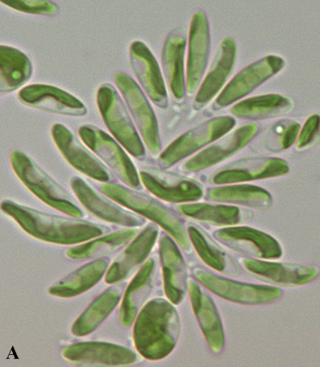
Cladonia rangiferina, also known as reindeer cup lichen, reindeer lichen or grey reindeer lichen, is a light-coloured fruticose, cup lichen species in the family Cladoniaceae. It grows in both hot and cold climates in well-drained, open environments. Found primarily in areas of alpine tundra, it is extremely cold-hardy.

Peltigera is a genus of approximately 100 species of foliose lichens in the family Peltigeraceae. Commonly known as the dog or pelt lichens, species of Peltigera are often terricolous, but can also occur on moss, trees, rocks, and many other substrates in many parts of the world.

Coccomyxa is a genus of green algae in the family Coccomyxaceae. This genus is defined by their small, elliptical to spherical shape, and the presence of a simple parietal chloroplast. These features, along with their occurrence in various lifestyles such as free-living, parasitic, or as photobionts, have been used to identify more than 40 species. Using additional morphological features, such as brown akinetes formation, allows for the differentiation between Coccomyxa and the genus Pseudococcomyxa, as they tend to share some morphological characteristics like the general cell shape and one-sided mucilage cap. Recent molecular analysis, however, indicates that the genus Pseudococcomyxa is contained within different Coccomyxa clades, signaling the fact that the two genera are the same. Coccomyxa has often been used as a model organism, and its genome is being completely sequenced. The genus is also an attractive candidate for biofuels.
Ophiobolus is a genus of fungi in the family Phaeosphaeriaceae.

Leptosphaerulina is a genus of fungi in the class Dothideomycetes. The relationship of this taxon to other taxa within the class was unknown in 2007 until it was placed within the Didymellaceae family in the Pleosporales order. The genus was first described by Australian plant pathologist Daniel McAlpine in 1902.
Neolamya is a genus of fungi in the class Sordariomycetes. The relationship of this taxon to other taxa within the class is unknown.
Zwackhiomyces is a genus of lichenicolous fungi in the family Xanthopyreniaceae. The genus was circumscribed by Martin Grube and Josef Hafellner in 1990, with Zwackhiomyces coepulonus assigned as the type species.

Neobarya is a genus of fungi in the family Clavicipitaceae.
Nanostictis is a genus of lichen-forming fungi in the family Stictidaceae. The genus was circumscribed in 1954 by Danish lichenologist Mogens Skytte Christiansen, with Nanostictis peltigerae assigned as the type species.
Hubertus Antonius van der Aa was a Dutch mycologist who described several genera and species of fungi. He studied at Utrecht University where he received his PhD in 1973 with the dissertation Studies in phyllosticta I.
Peltigera vainioi is a species of lichen in the family Peltigeraceae. It is found in high-elevation locations in South America. It is a somewhat unusual species in its genus, characterized by a single holdfast that attaches to its substrate, and pores in its cortex.

Corticifraga is a genus of lichenicolous fungi in the family Gomphillaceae. The genus was circumscribed by David Leslie Hawksworth and Rolf Santesson in 1990, with Corticifraga peltigerae assigned as the type species.
Taitaia is a single-species fungal genus in the family Gomphillaceae. It was circumscribed in 2018 to contain the species Taitaia aurea, a lichenicolous (lichen-dwelling) fungus. This species is characterized by aggregated ascomata with yellow margins, and salmon-red discs that originate from a single base. It is known only from a few sites in Kenya's tropical lower-mountain forests, where it grows on thalli of the lichen Crocodia.
Karsteniomyces is a genus of lichenicolous fungi of unknown familial, ordinal, and class placement in the Ascomycota. The genus was circumscribed by David Leslie Hawksworth in 1980. The species of this genus are found in Europe.
Knufia is a genus of fungi in the family Trichomeriaceae.

Polycoccum is a genus of lichenicolous fungi in the family Polycoccaceae. It has about 60 species.
Niesslia peltigerae is a species of lichenicolous fungus in the family Niessliaceae. It was described as a new species in 2020 by lichenologist Sergio Pérez-Ortega. The type specimen was collected in the Hoonah-Angoon Census Area of Glacier Bay National Park, in muskeg and forest. The fungus was growing parasitically on the lichen Peltigera kristinssonii, which itself was growing on mountain hemlock. The specific epithet peltigerae alludes to the genus of its host. Infection by the fungus bleaches the thallus of the host lichen.
Nanostictis caucasica is a species of lichenicolous (lichen-eating) fungus in the family Stictidaceae. It is known to occur only in a single locality in the North Caucasus region of Southern Russia, where it grows parasitically on the foliose lichen Parmelia sulcata.
Corticifraga peltigerae is a species of lichenicolous (lichen-dwelling) fungus in the family Gomphillaceae, and the type species of the genus Corticifraga. Its typical host lichen is Peltigera, although on occasion it is found on Solorina and Pseudocyphellaria. The fungus was first described in 1867 by the German botanist Karl Wilhelm Gottlieb Leopold Fuckel, who initially classified it in the genus Peziza. It has been transferred to several genera early in its taxonomic history, before ending up in Corticifraga, which was newly circumscribed by David Leslie Hawksworth and Rolf Santesson in 1990 to contain lichenicolous fungi previously referred to Phragmonaevia.






